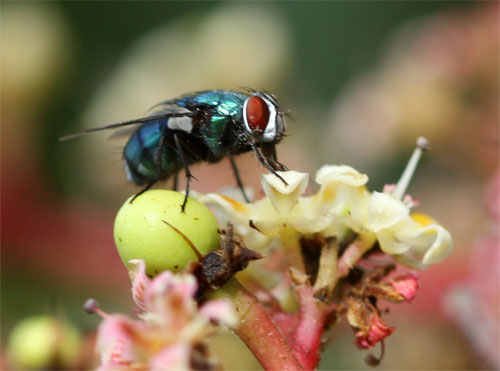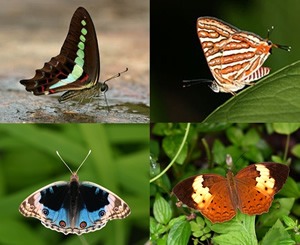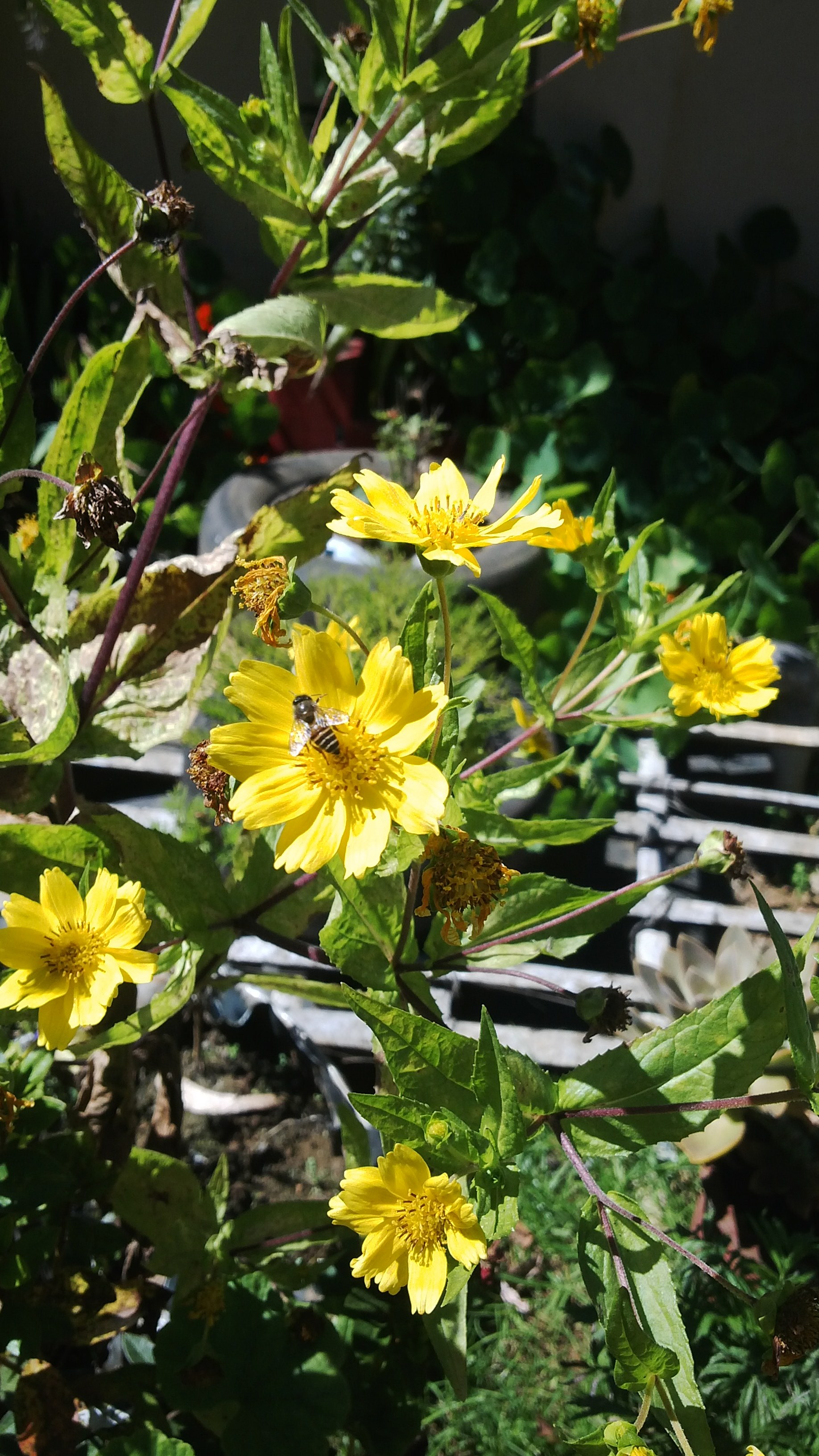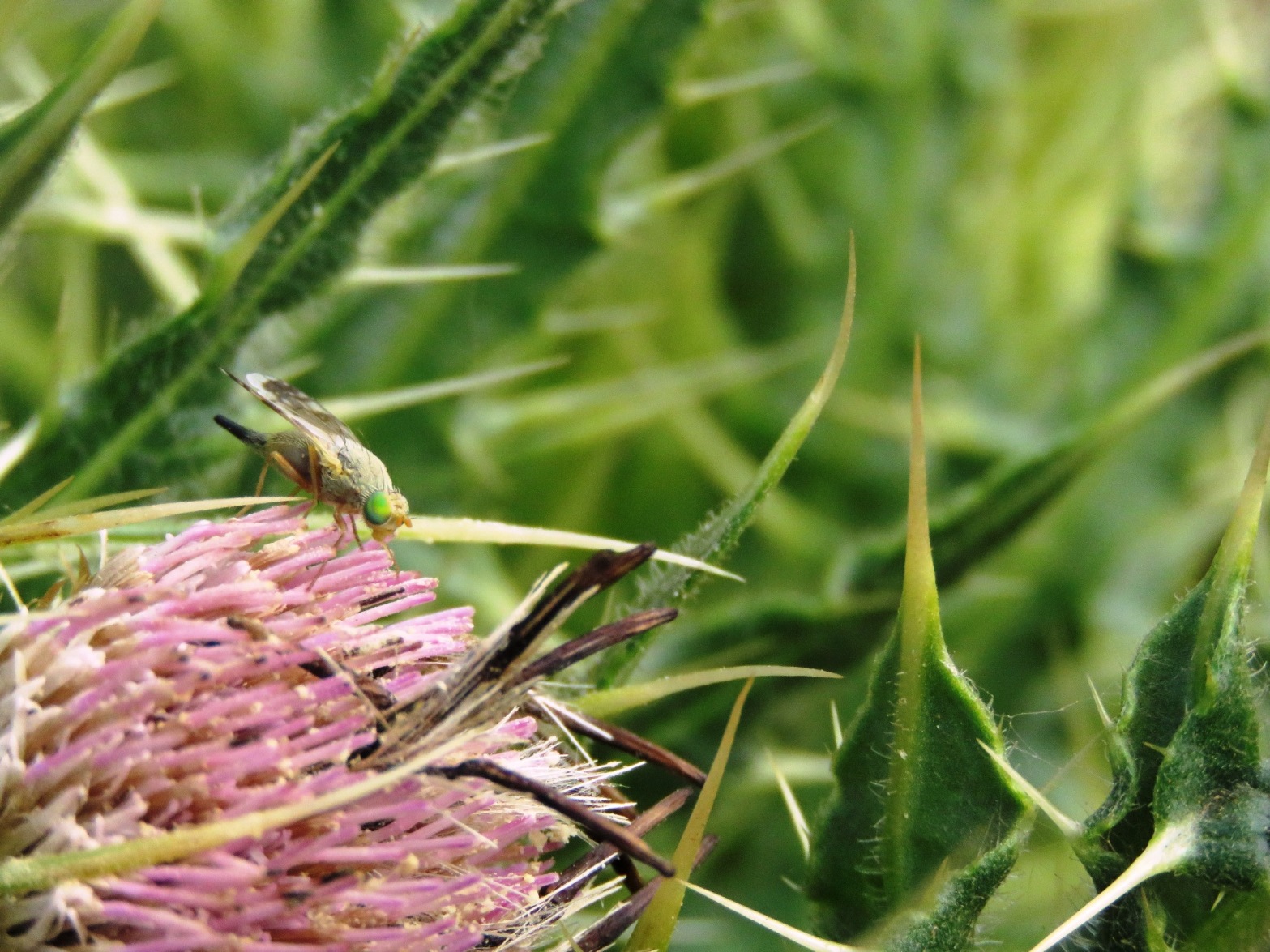
ORDER: Hymenoptera
FAMILY: Apidae
Bees are primary pollinators and are responsible for almost 60% of the pollination that takes place. This family includes the truly social honeybees, solitary and kleptoparasitic bees (parasitizing other bee nests by laying their eggs in host bee nests). The social honey bees are well known as pollinators as they produce the important forest product, honey. Solitary bees like digger bees, carpenter bees and other uncommon social bees like the bumble bees also play crucial roles in pollination.
Apis cerana
Common name: Asian honeybee
This is a commonly sighted social bee and an excellent pollinator of crops including: spice crops, fruits, nuts, oilseeds, cauliflower, okra, and onion. It has 8 subspecies. In some situations, Apis cerana is considered to be a superior pollinator compared to Apis mellifera.
Nesting Habits: In natural settings, nests in cavities where multiple combs are found. The Apis cerana is domesticated and hence also flourishes in man-made hives such as containers/boxes.
Apis florea
Common name: Little honeybee
It is one of two smallest honeybees found in Southeast Asia. These honey bees are important pollinators and therefore commodified in countries like Cambodia.
Source: http://eol.org/pages/2754888/overview
Suwannapong, Guntima, Mark Eric, and James C Nieh. Biology of Thai Honeybees : Natural History and Threats. N.p., 2011. Print.
Apis dorsata
Common name: Giant Rock Honeybee
These social bees are known for their aggressive defense strategies and vicious behavior when disturbed. Indigenous peoples have traditionally used this species as a source of honey and beeswax, a practice known as honey hunting. As a colony is initiated, the migration depends on foraging resources and predation risks. These bees travel to different sites depending on the blooming season of flowers. There are about 100,000 members in each colony and each colony resides in one nesting site for about 3–4 months at a time. Colonies tend to decline when resources, such as food, honey, and pollen, are depleted. Colonies decline during the rainy and summer seasons because of the instability of foraging sources due to climate change.
Nesting habits: A colony is generally seen occupying a single comb, high up on the undersides of cliffs or on tall trees. One to many combs may be found at one location.
Sources:
1. Starr, Christoper (1987). “Nest-site Preferences of the Giant Honey Bee, Apis dorsata (Hymeoptera:Apidae), in Borneo”.
2. Pan-Pacific Entomologist (63): 37–42.)
3. Raghunandan, K.S. (2013). “Colony status of Asian giant honeybee, Apis dorsata Fabricius in Southern Karnataka, India”.African Journal of Agricultural Research 8: 680–689.
Tetragonula iridipennis
Common name: Indian stingless bee
This is a tropical stingless bee species belonging to the complex genus Tetragonula with about 30 species in India. They are active nectar foragers, and thus are important as pollinators. Tetragonula honey is considered to be of medicinal value. For centuries, colonies of T. iridipennis have been kept in objects such as clay pots so that their highly prized medicinal honey can be utilized. T. iridipennis pollinates from many herbal plants such as the coco palm and the jackfruit tree. They also collect sap from tree species such as Cycas sphaerica. Seven species are reported from India in this threatened taxa.
Nesting habits: They are eusocial bees that nest in logs, wall cavities and even tree trucks.
Source: http://www.ijsr.net/archive/v4i1/SUB1566.pdf
Lepidotrigona ventralis
Common name:
Nesting habits: This small stingless eusocial bee has the habit of cavity nesting within hollow tree trunks, mud walls or man-made structures/containers.
Sources:
1. http://www.discoverlife.org/mp/20q?search=Lepidotrigona +ventralis
2. http://www.ajcb.in/journals/short_others_july_2014/AJCBVol3-No1-Vijayakumar.pdf
Tetragonula bengalensis
Common name:
The species found in India (the states of Uttar Pradesh and West Bengal and the Union Territory Puducherry)
Nesting habits: Small stingless eusocial bee whose habit is cavity nesting within hollow tree trunks, mud walls or man-made structures/containers.
Ceratina sexmaculata
Common name: Small carpenter bee
Nesting Habits : Named the small carpenter bee, these bees are solitary and nest in tunnels made in the soft pith of plant stems
Source:
https://en.wikipedia.org/wiki/Carpenter_bee
Xylocopa iridipennis
Common Name: Big carpenter bee
Nesting Habits : The large carpenter bees nest in the hollows of stems or rotten wood.
Source:
https://en.wikipedia.org/wiki/Carpenter_bee
***************************
ORDER: Hymenoptera
FAMILY: Megachilidae
Megachile spp; Euaspis spp.; Coelioxys spp.; Anthidiellum spp.; Lithurgus spp.
Common name: Leaf-cutter bee
Most belong to a cosmopolitan family whose habits are mostly solitary, while some may be Kleptoparasitic (parasitizing other bee nests by laying their eggs in host bee nests). They are important pollinators (e.g. legume crops such as beans) and their pollen carrying structure in on the underside of their abdomen (abdominal scopa). Their presence in the vicinity can be indirectly gauged by observing plants (e.g.) rose plants. Leaf-cutter bees line their nest with pieces of leaves and hence they cut out almost round pieces of leaves that will serve their purpose.
***************************
ORDER: Hymenoptera
FAMILY: Halictidae
Halictus spp.; Lasioglossum spp.; Nomia spp.
Common name: Sweat bee
Sweat bees form a family of metallic or non-metallic bees with a world-wide distribution. The family is divided into four sub-families and together, the habits of sweat bees vary from eusocial, to semi-eusocial to communal to solitary. Halictids thus show a great diversity not just in habits but also in their morphology. Sweat bees are the most in numbers with the exception of honey bees and thus contribute very greatly to pollination of various crops and wild plants.
Nesting habits: Nesting behavior also varies through the family but ground nesting/nesting in rotting wood is seen to be common.
Source:
1. A species checklist of the Halictidae from India can be accessed here @ http://www.ipublishing.co.in/ijesarticles/twelve/articles/volth ree/EIJES31015.pdf



